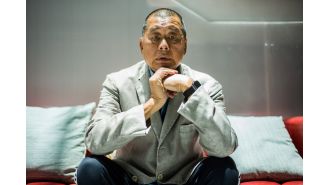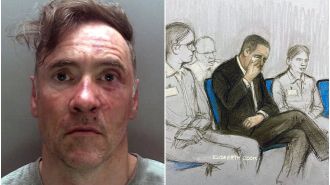Andrew Cuomo’s Report on Controversial Nursing Home Policy for COVID Patients Prompts More Controversy
A state report on Cuomo’s decision to order nursing homes to take in COVID positive patients in the early days of the pandemic fails to deal with the central question: did such admissions lead to more infection and death, and if so how significantly.

In defense of a controversial policy to send COVID-19 positive patients from hospitals into nursing homes, New York Gov. Andrew Cuomo’s health department issued a report on Monday saying that the directive did not significantly contribute to the nearly 6,500 deaths that have occurred to date in homes across the state.
Howard Zucker, commissioner of the New York State Department of Health, said at a news conference that sickened staff members were the chief source of infection for residents at the state’s more than 600 nursing homes. He said some 37,500 workers at the homes — nurses, administrators, maintenance staff — had tested positive for the virus since the pandemic began to sweep through the state.
The report said the staff members “transmitted the virus unknowingly — through no fault of their own — while working, which then led to resident infection.”
In the days since its release, the report has come under withering criticism, from some nursing home executives, medical experts, scientists, and elected officials in both New York and Washington. The critics have challenged the report’s conclusions as dubious speculation and accused Cuomo and Zucker of issuing a cynical document meant to insulate themselves from blame.
“I don’t think this report convincingly demonstrates that the policy was not another important driver of deaths,” said Denis Nash, an epidemiologist and executive director of the CUNY Institute for Implementation Science in Population Health. “The key consideration here is a question of ‘what if.’ What if there had been no such policy. … Would there have been fewer deaths? How many fewer? ... They didn’t fully leverage epidemiological methods to rigorously address that question, in my view.”
On March 25, Cuomo, saying he feared that an onslaught of COVID victims would overwhelm hospitals, issued an order that required nursing homes to accept COVID-19 patients being discharged from hospitals, so long as they were “medically stable.” Under the policy, the nursing homes receiving the patients were barred from testing the patients to see if they might still be contagious.
As ProPublica reported last month, New York’s nursing homes suffered a larger percentage of deaths relative to its total nursing home population than several states that did not have such a policy in place.
The state’s directive infuriated many health experts, families of residents and nursing home operators who said they were already ill-prepared and struggling to keep residents safe amid the growing COVID threat. They worried that the policy would needlessly lead to additional infections and deaths inside the homes.
Cuomo ultimately rescinded the policy on May 10, after more than 6,000 residents had died and the fears about overwhelmed hospitals had faded. At the time, Cuomo also implemented a range of measures to protect nursing home residents, including routine testing of all staff.
In its report, the health department minimizes any role the admissions of COVID patients might have played in the spread of disease in the homes, citing a review of data made available by the nursing homes themselves.
The report asserts that the majority of the more than 6,000 admissions of COVID patients occurred after the deadliest days at the homes. It says that some 80% of the homes that took in COVID patients had already seen either staff or residents infected. It also says that many of the COVID patients sent to the homes were likely not still contagious.
“If you were to place blame,” Zucker said of the number of people who died inside nursing homes, “I’d blame coronavirus.”
Michael Dowling, chief executive officer of Northwell Health, the largest hospital organization in the state, appeared at the news conference with Zucker and endorsed the report’s conclusions.
At the conference, he said the “study confirms what we saw in our own facilities around the state: that when the virus hit our local communities, it quickly spread through asymptomatic carriers into our nursing homes, hospitals, places of worship and other congregate settings.” But he did not respond to further questions for this story.
The report asserts that the highest number of nursing home staff reporting symptoms occurred on March 16, nine days before the controversial directive was issued. The peak number of reported nursing home fatalities, the report said, was reached April 8. The report uses the timeline to conclude that workers at the home were the ones driving infections and deaths.
To bolster that claim, the report says that the greatest numbers of daily COVID patient admissions did not occur until later in April.
“If admissions were driving fatalities, the order of the peak fatalities and peak admissions would have been reversed,” the report concludes.
Rupak Shivakoti, an epidemiologist at Columbia University’s Mailman School of Public Health, said a fundamental flaw with the report was that while infected workers at the homes might have been a major driver of infections and death, the report deals almost not at all with whether the admissions of COVID patients added to infections and deaths.
Indeed, while April 8 may have been the single deadliest day for nursing home residents — roughly 250 died — more than 4,000 additional residents would perish in the days and weeks to come as thousands of COVID patients continued to arrive at the homes.
“Their data needs to be much more convincing than just saying the peaks of the nursing home health workers infection matched a later peak of mortality,” Shivakoti said.
Catherine Troisi, an infectious disease epidemiologist at the UTHealth School of Public Health in Houston, also said this conclusion amounted to speculation on the part of the state.
“It certainly is circumstantial evidence,” she said. “There’s no way to provide causality.”
John Rowe, former CEO of health insurance giant Aetna and a Columbia University professor of health policy and aging, however, defended the state’s report as “pretty solid.” In an email, he said it contained “rather detailed analytics, lots of testing data, a large sample of nursing homes” and other important findings. He added that ProPublica could consider his opinion a “peer review, the term used by academic journals for the process of independently assessing research before publication.
Christopher Laxton, executive director of the Society for Post-Acute and Long-Term Care Medicine, has criticized the state’s policy as having been enacted without adequate input from experts in nursing home health care. He told ProPublica that the report amounted to “defensive politics on the part of the governor.”
He told ProPublica that the report amounted to “defensive politics on the part of the governor.”
In Washington, Rep. Steve Scalise of Louisiana, the Republican leader of a House subcommittee focused on the COVID crisis, said the report was consistent with Cuomo’s unwillingness to take responsibility for a misguided and deadly policy. Scalise has demanded that Cuomo turn over records related to the policy and the outcomes at the state’s nursing homes, but Cuomo has so far refused to do so.
“Disgusting,” Scalise said of the report.
On Thursday, Scalise sent a letter to Cuomo, urging his compliance with the congressional inquiry and saying many parts of the state’s report were “divorced from science.”
“NYSDOH’s report appears to be little more than your administration’s latest attempt to deflect criticism and shift blame for the consequences of your deadly nursing home order,” the letter said. “But blame-shifting, name-calling and half baked data manipulations will not make the facts or the questions they raise go away. The families of those affected by your March 25 order deserve answers about why it was put in place and, rest assured, we will not give up until we get those answers.”
Rich Azzopardi, an adviser to Cuomo, dismissed Scalise’s request for documents as partisan grandstanding, and mocked the idea that Republican lawmakers in Washington had much respect for science.
The health department’s report was done with the aid of the consulting company McKinsey & Co. The report says it drew on data collected from nursing homes through surveys. It does not list a single author by name, in or out of the health department. McKinsey itself is only listed in a footnote. The health department’s website lists four independent reviewers, none of whom are epidemiologists. Two are hospital executives: Michael Dowling, the Northwell hospital chain CEO, and Dr. David L. Reich, president and chief operating officer of Mount Sinai Hospital. Neither answered emailed questions for this story. The health department would not say who, exactly, authored the report, or how much it paid McKinsey for its involvement. McKinsey declined to comment for this story, but did not cite a reason.
“We will not have any comment. Thank you for reaching out,” DJ Carella, a spokesman for the company.
In determining that COVID patients discharged from hospitals could not have been a significant threat, the report says 252 of the 310 homes that received those COVID patients already had noted infected staff or residents.
The report seems to suggest that adding more COVID positive patients to those 252 homes did not increase the risk to the staff and residents.
The report is silent on a seemingly important question raised by its own data: Some 58 nursing homes did not have a single case of a sickened staff member or resident prior to the arrival of a COVID patient from the hospital. The report does not say how many, if any, residents or staffers at those homes became sick or died.
Asked by ProPublica about those 58 homes, Jonah Bruno, a spokesman for the health department, would not answer.
“They won’t address what happened when they sent COVID patients to homes with no COVID because it’s damaging to their false narrative,” said Steve McLaughlin, the Rensselaer County executive.
McLaughlin has publicly warred with Cuomo since the March 25 directive was issued. He refused to allow COVID patients into the nursing home run by the county, and the 300-bed facility has not had a single case of COVID. At Diamond Hill, a private nursing home in the county that took in four COVID patients, 18 residents died.
“The entire report is a whitewash and a sham,” McLaughlin said.
Bruno, the department spokesman, did not respond when told of McLaughlin’s claims.
The report, in arguing that the COVID patients did not add significantly to the death tolls, said that the COVID-19 positive patients were admitted to nursing homes at a median of nine days after hospital admission. The report claimed that most health experts agree such patients would no longer be infectious at that point.
In fact, the science on the length of infectiousness is still unsettled. The CDC, on its website, says just that.
Denis Nash, the CUNY epidemiologist, said the state’s own claim meant that roughly 3,000 COVID patients were sent to nursing homes within nine days after admission to the hospital, so by the Cuomo health department standard, many patients were still potentially contagious.
Nash said that it would be useful to know how many patients were sent to nursing homes one, two or three days after admission, when they were likely more infectious.
Shivakoti, the epidemiologist at Columbia, agreed.
“While ‘most’ of the patients were likely not contagious, at least at the peak of times, there might have been a small percentage who were,” he said. “Due to the easy spread in nursing homes, this is still a risk.”
Bruno did not respond when asked why the state chose to use the median as its metric.
The report compares the timing of peak deaths to peak admissions, but it reflects no effort to trace the path of viral transmission: There is no indication that the investigators tried to identify workers or the residents they cared for, or who may have given the virus to whom.
Jim Malatras, an adviser to the governor on the coronavirus response, seemed to concede its imperfections in a remark to a reporter for City and State.
“All you can do is measure things, and then point out the strongest factors,” he said, acknowledging that the science on how long someone can be infectious remains in flux. “If you put a gun to my head and say: You know with 1 million percent certainty?’ Of course not.”
ProPublica first contacted the health department on Monday with questions about the report, and asked for an interview with Zucker and some of the underlying data behind the report’s conclusions. Four days later, Bruno, the department spokesman, had not answered the questions or provided the data.
The state report says that “over the course of the crisis, New York State provided nursing homes with an unprecedented 8,510,729 pieces of PPE for their workers and others.”
The New York State Nurses Association believes that figure is deceptive and that the state provided too little too late. The association tried to sue the Department of Health earlier this year over its failure to provide sufficient protective gear to nurses in both hospitals and nursing homes. The lawsuit was ultimately dismissed because a federal judge said the association lacked standing.
In a letter released on Friday, the association said:
“New Yorkers deserve a full accounting of what happened over the past four months, and the NYSDOH nursing home report, unfortunately, does not move us forward. The need is plain for a comprehensive, independent review of nursing home practices, the role of for-profit operators, and NYSDOH oversight.”
Richard Gottfried, the Democratic chairman of the New York State Assembly’s health committee, has already called for such an independent investigation.
“The report seems accurate as far as it goes, but also somewhat beside the point if we are interested in determining the specific consequences of the governor’s March 25 directive,” Gottfried said. “The question about the order is not how the virus first got into the nursing homes. It’s whether patients returning from the hospital were still contagious, and what should be done if the patient is still contagious. The report was done by the head of the department under scrutiny, and endorsed by two hospital executives with close ties to the department. I respect all three. But the report would have been more valuable and reassuring if it came from independent medical experts, preferably academic.”
The state report argues that New York compared favorably to other states with respect to its nursing home death toll. It cites a New York Times analysis that found that New York “ranks 46th in the nation — meaning 45 states had a greater percentage of fatalities.”
But that ranking is based on the number of nursing home deaths relative to each state’s overall death count, not each state’s nursing home population.
By that count, New York might fare much worse.
As ProPublica reported last month, New York lost about 6% of its more than 100,000 nursing home residents. New Jersey, which had a similar policy, lost roughly 12% of its more than 43,000 residents. In Florida, where such transfers were barred, just 1.6% of 73,000 nursing home residents died of the virus. California briefly had a similar policy in place but then revised it, losing 2% of its 103,000 nursing home residents as of mid-June. Louisiana had stricter rules and lost 4%, suffering 1,075 deaths out of 26,000 residents.
Any state-by-state comparison is difficult to make because many states count deaths differently. New York, for example, does not count the deaths of nursing home residents in hospitals as nursing home deaths, as many other states do.
In defending its policy, the Cuomo administration has stressed that nursing homes incapable of safely caring for COVID patients could have declined to accept them. Several nursing home experts have said many homes feared denying admissions because of the state’s directive.
Shivakoti of Columbia said he thought it would have been preferable for the state, along with doctors and hospitals, to have decided where COVID patients could have best been cared for.
“All this was likely difficult to do for the first wave but can be planned for the subsequent waves,” he said..
Tamara Kanetzka, a University of Chicago professor of public health sciences, said that the New York mandate to send COVID-19 patients to nursing homes was “misguided,” and that certain aspects of the report were speculative or disingenuous.
But she accepted that staff members were likely the single greatest source of infection at the homes.
What is beyond dispute, however, is that county, local and federal authorities had “grossly failed nursing home residents nationwide and probably will continue to do so as the virus surges in much of the country,” she said.
“We need to stop finding people to blame and try getting resources and assistance to nursing homes located in the new virus hotspots,” she said.






